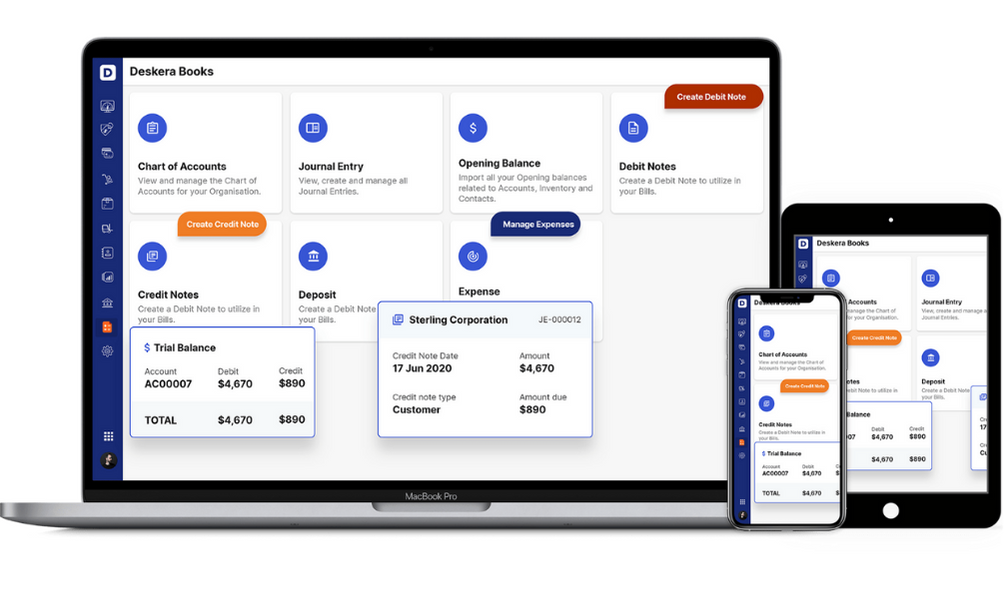Return on Equity (ROE) is a metric that tells investors how well a firm manages the money that its shareholders have invested. We can say that it assesses a profit margin concerning its stockholders' equity.
If you are an investor who wants to learn in-depth about the return on equity, this post shall guide you. Here are the points that we shall cover in this article:
- Definition of Return on Equity (ROE)
- ROE Formula
- How does the Return on Equity work? (Example)
- Understanding Return on Equity
- Advantages of Return on Equity
- Drawbacks of Return on Equity
- The DuPont Formula
- Conclusion
- How can Deskera Help You?
- Key Takeaways
Definition of Return on Equity (ROE)
Return on Equity is a metric that evaluates a company's net profits in relation to each dollar of equity invested by shareholders.
The ROE statistic, which is usually stated in percentages, can be a technique to assess a management team's capital allocation decisions and capacity to create shareholder value.

Return on Equity, abbreviated as ROE, is a metric that measures how lucrative a firm has been after accounting for the contributions of its shareholders.
The ROE metric seeks to answer the question: "For each dollar invested by equity owners, how much in net profit does the company generate?" The percentage of investor capital transformed into net income, expressed in dollars, indicates how efficiently the company manages the equity capital granted to them.
ROE Formula
The formula for calculating the return on equity measure is simple: it divides net income by the average shareholders' equity balance in the previous and current periods. Here is how it appears:
The terms used in the formula are described as follows:
Net Income: The net income reflects the company's after-tax profits and is found at the bottom of the income statement; therefore, it is also known by the nickname "bottom line." These are also known as net earnings.
Shareholders' Equity: The shareholders' equity is one of the three basic components of the balance sheet and denotes the amount of investment made by the shareholders.
Simply put, if the company's assets were liquidated and then used to pay off all existing debts and liabilities, the remaining value would be the shareholder's equity because equity claims are at the bottom of the hierarchy. The shareholders' equity balance can be found on the balance sheet, or it can be determined by subtracting the company's liabilities from its assets. Because a company's total assets minus its total liabilities equals its shareholders' equity, ROE is also known as "return on net assets."
How does Return on Equity work (Example)?
To understand how the Return on Equity works, we shall consider the following example:
You will need your balance sheet and the income statement to find the numbers that can be entered into the formula to calculate ROE.
The formula of ROE:
Let's say the net income for Company ABC in the last period was $20,000,000, and the average shareholders' equity for the period was $208,000,000.
Plugging these values into our formula, we get the following:
ROE = 0.0961, or 9.61% (after multiplying by 100 to convert to get a percentage value)
This gives us the value of ROE for the company ABC; however, it is always recommended to have a comparative analysis drawn between various competitors of the company. This is important as the average ROE oscillates significantly across the various sectors. Therefore, having a comparative analysis presents a clearer picture.
Understanding Return on Equity
Return on equity (ROE) is a valuable indicator for determining how effectively current and new equity investment in the business is being used. If a company's ROE constantly improves throughout time, it's a good sign that management creates more favorable profits for investors. The greater the ROE, the more net profits the company earns on the funds granted by stockholders.
The return on equity ratio reflects the rate of return received by the company's common stock owners in exchange for their investment. Return on Equity measures how effective a company is at generating returns on the investments made by its shareholders.
The annual return on equity (ROE) of a corporation is calculated by dividing its net income by the total equity of its shareholders.
ROE is often used as a metric to determine how effectively a business uses its assets to create profits. ROE measures a company's capacity to turn its equity investments into profits by calculating total returns on equity capital.
Advantages of Return on Equity
The section underlines the importance and usability of evaluating the ROE. Here they are:
Recognizing Challenges with the ROE Ratio
Excessive liabilities, unpredictable returns, and low income are just a few of the difficulties that the ROE ratio can look at. However, a very high ROE ratio may signal a hidden danger or issue.
For example, if a company's net income is significantly large compared to its equity, a high return on investment (ROI) is considered great performance. However, equity that is less than net income sometimes indicates hidden hazards.
Calculating the rate of growth
The return on equity ratio is regarded as a useful tool for determining a company's stock and dividend growth rate.
A company's ROE is usually multiplied by its retention ratio to quantify such growth. The retention ratio indicates the percentage of a company's net income that is kept or reinvested to improve its growth prospects.
Determining Viability of the Growth
Return on equity ratio research also aids in determining a company's growth sustainability. Investors can use this financial measure to identify more vulnerable stocks to market risks and financial instability.
Investors can also use the ROE ratio to estimate a company's dividend growth. An accurate approximation can be generated by multiplying the company's ROE with its payout ratio.
A company's dividend growth rate that is higher or lower than the sustainable growth rate may signify operational hazards.
Drawbacks of Return on Equity
The following points highlight the limitations of the Return on Equity.
- Share buybacks can potentially affect the return on equity ratio. The number of outstanding shares is lowered when management repurchases its shares from the market. As the denominator shrinks, ROE grows.
- Another flaw is that some ROE ratios may disregard intangible assets when calculating shareholder equity. Non-monetary commodities such as goodwill, trademarks, copyrights, and patents are examples of intangible assets. This can lead to inaccurate computations and make it difficult to compare to other companies that have opted to include intangible assets.
- The ROE ratio's composition is subject to some change, and this may result in confusion and disputes among analysts.
The DuPont Formula
DuPont Corporation's management created a model called DuPont Analysis for a detailed examination of the company's profitability. The DuPont Analysis is a tool that can assist us in keeping away unnecessary false assumptions about a company's profitability.
There are numerous complications to analyzing a company's profitability. When we use the book value of the company's common equity in the ROE formula, and if it changes, the results could be misleading. We can employ a more in-depth analysis of this measure to avoid erroneous conclusions based on the ROE analysis.
The DuPont method divides ROE into three parts, each of which is important when considering a company's profitability. The product of a company's net profit margin, asset turnover, and financial leverage is the return on investment (ROI):
If the net profit margin rises in due course of time, the company effectively controls its operating and financial costs, and the ROE should rise. When asset turnover rises, it is indicative of the company is making better use of its assets, resulting in greater sales per dollar invested. Finally, as the company's financial leverage rises, it can use debt money to boost returns.
Conclusion
Return on Equity is a metric used to assess a company's capacity to create profitable returns for its shareholders over a specific time period. However, ROE should not be used as the sole criterion for investment decisions because of its shortcomings. When compared to the ROE of past periods of the same firm or the market, ROE has meaning, but it might be deceiving due to variances in accounting processes and calculations.
How can Deskera Help You?
Deskera Books is an online accounting, invoicing, and inventory management software that is designed to make your life easy. A one-stop solution, it caters to all your business needs, from creating invoices and tracking expenses to viewing all your financial documents whenever you need them.

Key Takeaways
- Return on equity (ROE) shows how much profit a company made in relation to its shareholders' total amount of equity.
- The percentage of investor cash converted into revenue is known as return on equity
- The return on investment (ROI) measures how efficiently the company's management allocates capital
- To calculate return on equity, divide net income by average shareholders' equity and multiply by 100 to translate to a percentage
- It's best to compare a company's ROE to that of other businesses in its industry
- The net income reflects the company's after-tax profits and is found at the bottom of the income statement; therefore, it is also known by the nickname "bottom line."
- The shareholders' equity is one of the three basic components of the balance sheet and denotes the amount of investment made by the shareholders
- Return on equity (ROE) is a valuable indicator for determining how effectively current and new equity investment in the business is being used
- Recognizing challenges with the ROE ratio, calculating the rate of growth, and determining the viability of the growth are some of the advantages of ROE
Related Articles














